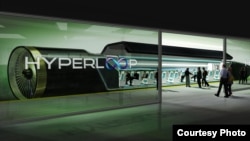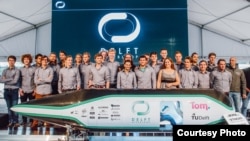A system to transport bullet-shaped people movers at super-fast speeds recently got its first real-world test.
The system, called Hyperloop, was the idea of American businessman Elon Musk. He created and owns the aerospace company SpaceX, as well as electric carmaker Tesla.
Musk decided to hold an international competition for people to build working models of the proposed transportation system. Its vehicles would travel through low-pressure tubes, what Musk calls a Hyperloop. His goal is eventually to provide transportation between cities that is faster, safer and costs less than current high-speed trains.
Musk says Hyperloop could carry people from Los Angeles to San Francisco - a distance of 600 kilometers in 30 minutes. Driving that same distance in a car would take nearly six hours. A high-speed train trip would take about two hours.
Hyperloop would be designed to reach a top speed of about 1,200 kilometers an hour. Currently, the fastest train in the world is being tested in Japan. So far, it has reached a top speed of 603 kilometers per hour.
The system, which is still in early development, uses vehicles known as pods. An electromagnetic force causes the pods to “float” on air inside a series of steel tubes. Air would then be forced out of the tubes to reduce pressure and lower the resistance for the vehicles.
A total of 26 engineering teams recently gathered in Los Angeles to test their Hyperloop model vehicles. The vehicles were sent through a 1,600-meter-long vacuum tube built by SpaceX.
Musk said the competition was meant to get engineers thinking about how to create completely new methods of transportation.
“What this is really intended to do is to encourage innovation in transport technology. To get people excited about new forms of transport - things that may be completely different from what we see today.”
The top speed award went to a 35-person team from Germany’s Technical University of Munich. Josef Fleischmann is a member of the WARR Hyperloop team. He said it was exciting to win after working on the model for the past 18 months.
“Well, it went pretty well. We went down all the way, reached 93 kilometers per hour. So all of our subsystems worked. We’re pretty happy.”
Another team, rLoop, was made up of 140 young engineers from all over the world. All of them cooperated on the project remotely. The group’s lead engineer, Tom Lambot, said many members met their teammates for the first time at the competition.
“The first time we tested the vehicle was when we came to the competition. And it was also the first time some of us that have been working on this for a year-and-a-half ever met in person.”
Among other things, the pod vehicles were tested for efficiency, stabilization and braking – being able to stop quickly. Cameras recorded video of the tests from inside the tubes.
The highest overall rating went to a team from Delft University of Technology in the Netherlands. Delft Hyperloop team member Mars Geuze said his group was able to build a comfortable, nice-looking vehicle that also performed well.
“We designed a completely integrated vehicle, even with a passenger compartment, with lighting and an interior.”
An engineering team from the Massachusetts Institute of Technology (MIT) won third place for design and construction. It was also given the top award for safety and reliability.
SpaceX says the next Hyperloop competition – which will focus on top speed – will be held later this year.
I’m Bryan Lynn.
George Putic reported this story for VOANews.com. Bryan Lynn adapted it for Learning English. His report also includes information from the Associated Press. George Grow was the editor.
We want to hear from you. What are your thoughts on this proposed new form of transportation? Write to us in the Comments section, and visit our Facebook page.
________________________________________________________________
Words in This Story
electromagnetic – adj. relating to the science dealing with the relationship between electricity and magnetism
vacuum – n. empty space where there is no air or other gas
remotely – adv. from a distance, away from others
stabilization – n. in a steady state with little movement
braking – n. system used for slowing or stopping a vehicle
comfortable – adj. physically pleasant, relaxed
integrated – adj. different parts working together as a unit
reliability – adj. how trusted something is to perform correctly









